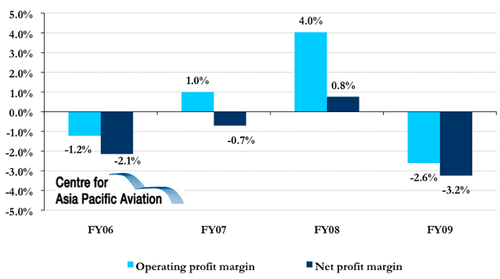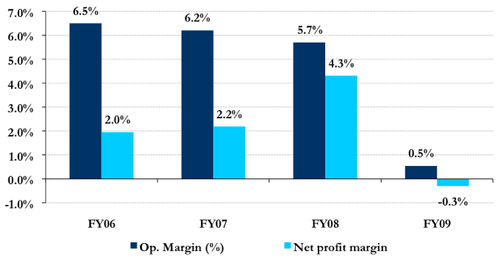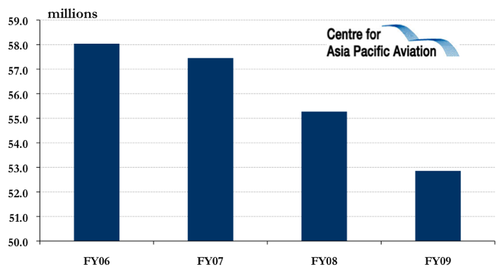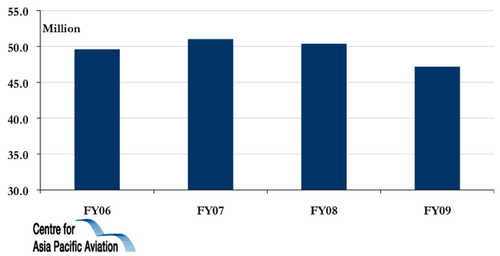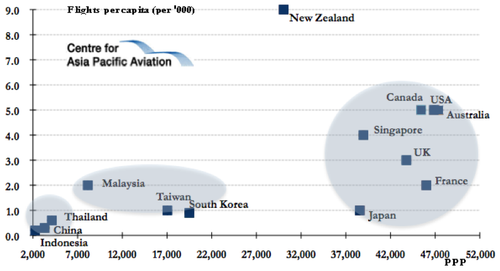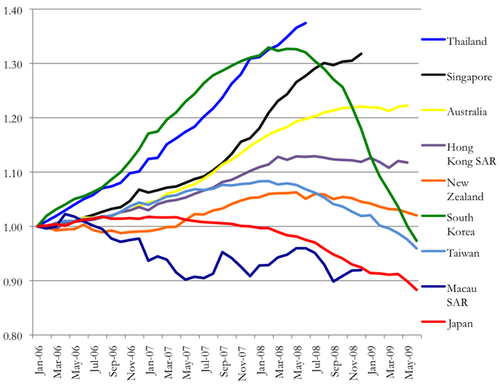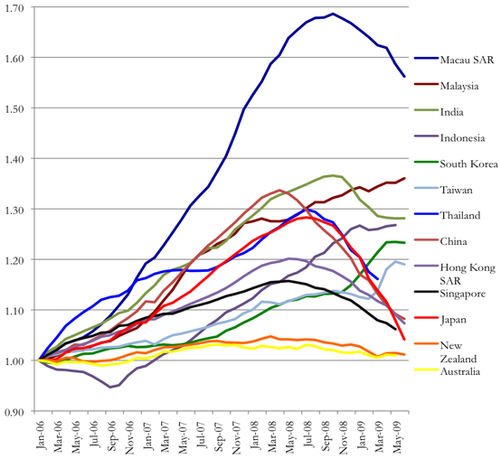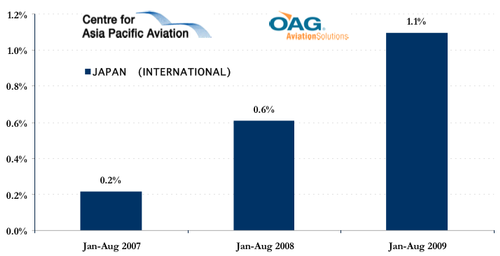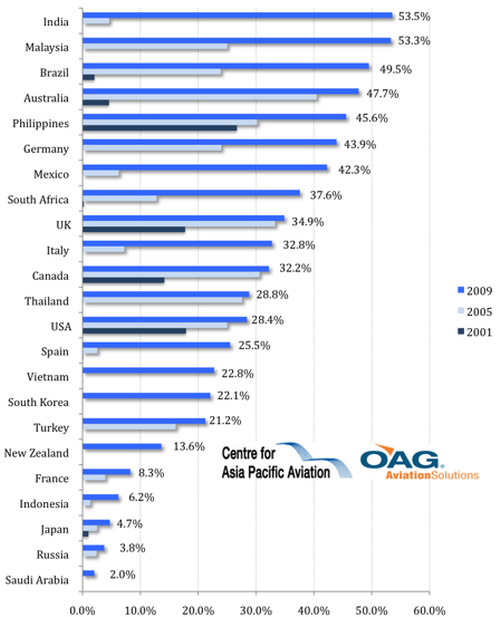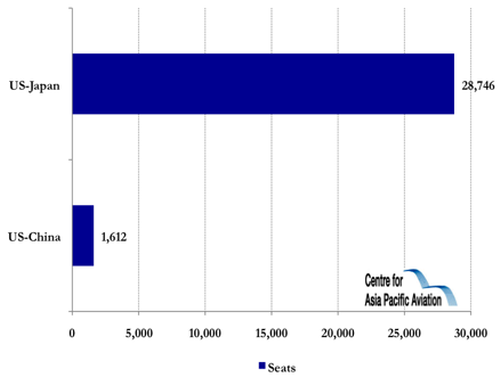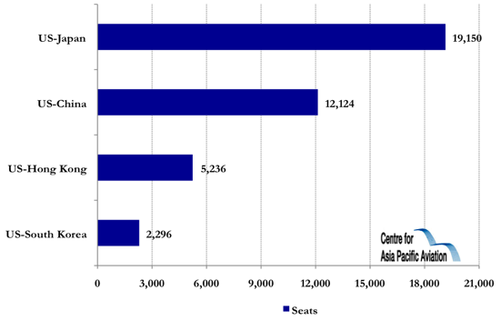Japan Airlines dances with SkyTeam and oneworld. Three weeks that will reshape North Asian aviation
China may be the aviation market of the future. But Japan today remains a highly significant country in North Asia for several reasons. In a relatively small geographic area, it is the home of countless major global companies and has among the highest levels of GDP per capita in the world. Its market is far higher yielding than its near neighbours and therefore far more attractive to foreign airlines, especially the Americans and Europeans.
Now, as its longstanding global aviation brand, Japan Airlines (JAL), stands at the precipice, Japan also may offer the key to unlocking an enormous untapped market, where flag carrier protectionism is still the starting point for international regulation. Today the airline, beleaguered for years, needs more than a bailout - it needs a partner. And the process of gaining that partner - whether it be SkyTeam's Delta and Air France, or oneworld's American Airlines, British Airways and Qantas - is likely to force Japan's new government into accepting an open skies agreement with the US.
That is because the only thing that would make it worthwhile for those airlines to pour several hundred million dollars in equity into JAL is if they can act as one airline on routes to and from Japan. And the only way to achieve that is to gain US anti-trust immunity. In turn, the US will only grant immunity if there is no constraint on other airlines entering the market: an open skies agreement.
And, as this complex story unfolds, open skies between the US and Japan would deliver extensive additional pressure on China and Korea to relax market controls. China is the most restrictive of the three at present, but the other two countries have been able to shelter in the halo that China's conservatism provides. Next year, a further bilateral regulatory relaxation between the US and China is to occur, on the path to a sort of open skies, making the timing of the JAL moves all the more pivotal.
2010 is also important for another reason: Tokyo's Narita and Haneda airports will expose new capacity to a demanding airline industry, removing another excuse which Japan has used for years to avoid opening up. So open skies would actually mean real change.
From Japan's side, the new DPJ government needs a fix that will help it solve a dilemma. It cannot simply bail JAL out, even if there is renewed action to restructure the ageing and sclerotic company. That would send the wrong message to a host of other ailing organisations whose begging bowls are lined up outside the Diet. Just the fact of having a major foreign airline or two as shareholders with a strong vested interest in JAL's future will be enough to encourage private financiers to advance large layers of debt, helping solve the problem.
Japan has said that a decision is to be taken in mid-October about which airline(s) will be selected to buy in. That leaves only three weeks to resolve a host of issues, not the least, what price will be paid and what that price will bring.
Meanwhile, across the Pacific, any grant of anti-trust immunity cannot however be assumed a shoo-in. A certain very powerful Congressman, Rep Oberstar, has been on a mission to prevent the spread of what he believes to be the anti-competitive nature of such alliances. But, raising the political stakes a little further - although everyone involved would fiercely deny any connection - the DPJ's pre-election rumblings about withdrawing support for US bases and for US forces in Afghanistan may make the Administration keener than usual to assist the Japanese government.
But this event will have repercussions that will be felt for years. Aviation's tectonic plates, the industry's archaic regulatory structure and the global airline alliances that have arisen from it, are shifting. It is therefore perhaps fitting that earthquake prone Japan is at the epicentre.
A week ago, when reports surfaced that Delta Air Lines, fresh from its takeover of Northwest Airlines and trans-Atlantic alliance with Air France-KLM - was preparing an audacious bid for Japan Airlines in the rival oneworld camp, it was clear that this was not just another airline investment.
Any realignment of the ownership and control of JAL will have profound consequences for the region's - and the world's - balance of aviation power.
In the race to save JAL, what is attracting the potential bidders? What does JAL need? And what will be the implications for All Nippon Airways, the global alliances and the wider industry? How will it affect Tokyo's (and Japan's) role as a transfer hub? What will be the impact on surrounding neighbours, notably Seoul's Incheon, whose key tenant, Korean Air, will be watching with some concern as its SkyTeam partners court a neighbouring rival? This is about a lot more than rescuing JAL.
JAL - a brief history of its life and (tough) times
JAL dates to August 1951 when it began domestic service using a Philippine Airlines DC-3. By October 1951, five Martin 202s had been leased from Northwest which also handled flight operations. In 1952, Northwest supplied JAL with DC-4 aircraft, also for domestic use. International service was finally begun in February 1954 to San Francisco using a DC-6B.
An air services agreement between post-war Japan and the US was concluded in 1952 and gave two US carriers, Northwest and Pan Am, full fifth-freedom rights from Tokyo to virtually any point in Asia. These highly unusual provisions, now held by Delta and United Airlines, continue to this day, making it possible for both carriers to operate hubs in direct competition with the Japanese carriers - not only to/from the US but also to numerous points in Asia.
As such, Japan is a high stakes market for United (and its Star Alliance partners, including ANA, Singapore Airlines and Lufthansa) and Delta and its SkyTeam allies (including Air France-KLM, Korean Air and China Southern Airlines).
JAL has had a chequered recent history. Slumping to a USD1 billion first quarter loss (to 30-Jun-2009), JAL is expecting to report another full-year loss this financial year - its fourth in five years.
Japan Airlines operating profit margin and net profit margin: FY06 to FY09
Rival All Nippon Airways stumbled last year, but is expecting to return to profit this year, targeting a JPY3 billion net result. Overall, ANA has done a relatively good job to restructure its business and build partnerships. It joined the Star Alliance early and has built up considerable momentum in winning market share from JAL in recent years, while JAL pursued an independent strategy.
Slowing ANA's progress however have been the ongoing delays to the B787 programme, for which it was a launch customer. It is difficult to estimate the impact of the delays on ANA, but it is safe to assume JAL would probably be in even poorer shape today if the B787s had begun to deliver to ANA on time last May.
ANA operating profit margin: FY06 to FY09
Too little, always too late for JAL, as the world has changed around it
JAL is a diminishing airline in many ways. This is by no means the airline's first large scale restructuring exercise - it has a steady recent history of attempts to rein in its bloated cost base and unwieldy structure - but most of these efforts have failed in delivering the quantum of change required, let alone what was originally set out to achieve.
Recent JAL restructuring plans
|
Jan-2007: FY2007-2010 Medium Term Revival Plan |
|---|
|
Reduce workforce from 53,100 to 48,800 employees by the end of FY2009, a reduction of 4,300 persons (including reduction of 3,500 employees through increase of productivity by 10%). Aims to shrink Group personnel costs from and after FY2007 by JPY50 billion compared with FY2006. Maintains the 10% reduction of basic salaries (introduced in April 2006). To implement a special early retirement program revised retirement benefit-related systems, review of allowances and bonuses and take other large scale personnel cost reduction measures. |
|
Feb-2008: FY2008-2010 Medium Term Revival Plan |
|
Moves to speed up the reduction of its workforce on a consolidated basis from 53,100 staff at the end of FY2006 to 48,800 staff by the end of FY2008. JAL will continue to keep personnel costs down so that every financial year personnel costs are 50 billion yen lower than the level in FY2006. JAL will continue to reduce personnel costs - the Group's biggest fixed expense - resulting in a reduction in costs of JPY10 billion yen on a yearly basis. |
|
May-2009: FY2009 Management Plan |
|
Further intensify cost reduction measures. Aiming to drive costs down even more drastically, to achieve a cost restructure that can endure risks from external influences, attention will be focused principally on the following 9 areas in FY2009:
|
The carrier's close links to government and the power of its unions have previously generated a powerful inertial force against radical redirection.
The response to its ongoing losses has been to progressively withdraw capacity, accelerating the suspension of loss-making international routes, in particular, over the past 12 months.
Japan Airlines passenger numbers: FY06 to FY09
Rival ANA is also trimming capacity in response to the slowdown, but far less dramatically than JAL.
ANA total passenger numbers: FY06 to FY09
The 'Emergency Revival Plan' - a last chance for JAL?
Last week JAL unveiled its Emergency Revival Plan under which it would cut 6,800 jobs by Mar-2012, slash capacity and seek an equity alliance with a foreign carrier. This looks meaningful on paper, but the proof will be in the delivery.
A 30% reduction in cost, if it translated into a similar reduction in ticket prices, could grow the high fare Japanese market by 50% in five years. And expanded access to a more open north Asian market has massive upside, especially for any airlines with an inside track.
The Centre has estimated previously that the upside for an intra-north Asian market freed of entry restrictions could add anything between 1-3 million additional air passengers a year to this population-intensive sub-region. It is these prospects that have captured the interest of the bidders, particularly with JAL's currently depressed share price.
With a continuing fierce outlook for the airline industry over the next 18 months, JAL has to get it right this time. Another chance is unlikely to come its way.
JAL's Emergency Revival Plan, 14-Sep-2009
- Job reductions: Will reduce workforce by approximately 14% (equating to 6,800 job cuts) by 2011/12, with job cuts and early retirements to commence this year. The move is part of efforts to reduce operating costs by 30%;
- Capacity reductions: Planning a "drastic" network reduction, for reportedly the largest reduction of routes in its history. The reductions reportedly includes the elimination of approximately 20 international services, or approximately 20% of its international network, through FY2011, commencing in Oct-2009, as the company reportedly seeks to reduce the ratio of its international flights to less than the current 50% of overall flights;
- Agreement with foreign airline: Plans to complete talks on a tie-up with a foreign carrier by mid-Oct-2009, although no partner was specified. The carrier is currently in talks with Delta Air Lines (SkyTeam) and American Airlines (oneworld), with a tie-up to cover codesharing. It has been reported that the US carriers are considering investments of up to USD300 million in JAL, with Air France-KLM also reportedly in discussions regarding a potential investment of up to USD300 million. It has also been speculated that British Airways and Qantas (oneworld) are interested in investing in JAL. Both American and Delta have recently reinforced their war chests with large capital raisings.
For buyers, the risks compare with the potential rewards
The key issue for would-be investors is that JAL's restructuring is expected to cost USD2-3 billion to complete over almost three years - a long investment horizon and a massive figure to bankroll, at a time when most of the possible investors have troubles aplenty at home.
Proposed investments by Delta and American and their European counterparts in the order of USD300-500 million have been reported, but the remaining sources of financing are unclear. All will be anxious to avoid a bidding war, but the winners could buy a large ticket to global pre-eminence, if they can see out the short term. This might be a big if. The benefits from codesharing, joint scheduling and pricing in a competitive market take time to accrue. There will be few short-term gains, with the prospect of potentially considerable future cash injections for anyone who gets involved. JAL is not going to become profitable overnight, although it can perhaps stem a lot of the recent bleeding by cutting back severely.
Purchasers are sure to argue for very tight provisions in the purchase conditions concerning the form that JAL's restructure must take. The last thing a new part owner would want is for JAL's unions to see the investment as a carte blanche to continue business as usual. A very high degree of pain is going to have to be suffered, if that impression is to be dismissed. But too fierce a process could eventually backfire, so a careful path must be trod. And issues like securing assurances from government about slot access at Tokyo's airports will be important in order to account for future expansion.
But the question remains: if JAL can't overhaul itself, what hope does an American or European airline have of doing so? The dangers of being trapped in a passive minority investment are never far away in buy-ins of this type. And apart from understanding the cultural nuances of a domestic retail market which is undergoing upheaval too, a new investor needs to understand, in an Asian context, the "new age" management issues of product segmentation, sales and distribution and a market where LCCs - including proliferating full service airline subsidiaries - offer quite different equations.
The nature of the Japanese market: not active by global standards
During the 1980s, when the Japanese economy seemed destined to rule the world, the Japanese tourist became a ubiquitous fixture on the global tourist circuit. That picture of a population constantly in motion has persisted to this day. However, the reality is that the Japanese have a relatively low propensity to travel, notably when the country's high GDP per capita is reflected.
Selected countries' GDP per capita^ and propensity to travel* by air
Japanese outbound market in decline
Japanese outbound traveller numbers - vital to the health of many tourism-based economies within the Asia Pacific region and beyond - has been in decline for several years. This partly reflects the country's economic stagnation, but it is not aided by external security and health shocks, exchange rate fluctuations and high ticket prices. Japan's travellers are highly risk-averse; the recent swine flu scare in early summer, slashed travel levels temporarily and a return of the virus in winter would for example have a rapid reaction.
Resident departures growth by country (Index 1 = Jan-2006) (12 months rolling averages): Jan-2006 to Jun-2009
Arrivals have also stagnated
Japan has also underperformed its regional peers in terms of attracting inbound visitor arrivals:
Visitor arrivals growth by country (Index 1 = Jan-2006) (12 months rolling averages): Jan-2006 to Jun-2009
Notes: China: Foreign arrivals only, Taiwan: Total Arrivals, HK: Excludes arrivals from China/Macau, Macau: Excludes arrivals from HK/China, Indonesia: Total arrivals all modes, Malaysia: Total Tourist Arrivals, Thailand: Thai nationals resident overseas excluded, Singapore: Total Arrivals excluding Malaysian citizens arriving by land, includes excursionists, Malaysia: Total Tourist Arrivals
Less pressure to change
For better or worse, most of the world's airlines have been forced to compete with growing numbers of new generation carriers with different business models and generally much-lower prices. And most of that competition has come first in domestic markets - or within the EU bloc. The competition was not always welcome, but it did force more timely adjustments.
The isolation of the Japanese domestic market has done JAL no such favours. Both JAL and ANA carry far more domestic traffic than international and the absence of a new generation domestic competitor has put off the kind of change evident elsewhere.
JAL and ANA Pax carried F/Y 2008
|
International |
Domestic |
|
|---|---|---|
|
11,704,043 |
41,154,433 |
|
|
ANA |
4,827,000 |
45,557,000 |
And LCCs currently account for less than 5% of the Japanese domestic market.
LCC market share in Japan domestic
Internationally, only 1.1% of the capacity in Japan is offered by LCCs, almost exclusively by foreign carriers, although this is about to increase.
LCC market share in Japan international
LCC are a minimal (and declining) challenge in Japan's domestic market, unlike most other major developed economies.
Domestic LCC penetration (Capacity share - seats) (%): Major markets#: 2001 to 2009*
While many airlines would, in theory, delight at the prospect of such limited competition, it is equally evident that JAL in particular, absent such pressure, has found itself at a global competitive disadvantage. Experience from other markets strongly suggest that JAL's reform process would have been much more effective if a real threat had existed. Instead, over recent years, JAL (and ANA to some extent) had actually focussed on expanding its premium market domestically.
The New World Order; too big to walk away from
To the extent that JAL - or, more accurately, extensive access to the Japanese market and its international potential - is available, this opportunity simply cannot be ignored. Even if the bidders have qualms about the depth of the hole they may be leaping into, it is extraordinarily difficult for management to walk away from an opportunity of this magnitude.
Quite simply, Asia will be at the centre of global aviation growth over the coming decades.
For example, Airbus has just released (17-Sep-2009) its updated and revised Global Market Forecast, projecting approximately 25,000 new passenger and freighter aircraft, valued at approximately USD3.1 trillion, will be delivered worldwide from 2009 to 2028, driven by:
- emerging economies,
- evolving airline networks,
- expansion of LCCs,
- traffic growth and the replacement of older aircraft.
According to Airbus, the greatest demand for new aircraft will come from airlines in the Asia Pacific region and emerging markets, with China and India accounting for 31% of the total demand. Europe and North America will only account for 25% and 23% respectively. And a lot of that will be replacement of old aircraft.
Boeing Commercial Airplanes too has reiterated (09-Sep-2009) its forecast that the Asia Pacific region will become the world's largest aviation market over the next 20 years, requiring 8,960 new commercial jets valued at approximately USD1.1 trillion. The Asia Pacific market is the largest forecast for new aircraft in terms of both units required and market value.
The Asia Pacific region will grow from 31 to 41% of the world air travel market between 2009 and 2028. Over the 20-year forecast period, Boeing expects 5,600 narrowbody, 2,590 twin engine widebody and 330 large widebody deliveries, as well as 440 regional jets. The Asia Pacific aircraft fleet will nearly triple from 3,910 to a total of 11,170 aircraft.
Who offers the best partner benefits?
Apart from the headline grabbing equity investment dollar number, whether it be USD300 million or USD1 billion, this is only the starting point in a complex decision process that is being compressed into these coming three short weeks.
On one front at least, Delta has a powerful argument. It probably has more to offer in terms of strengthening JAL's position.
Reflecting the 1952 Japan-US bilateral, both United and Delta maintain a strong position in the Japanese market. The table below lists the services provided between Tokyo and the US for the four major players. But Delta, building on its Northwest purchase is far ahead in service levels.
Tokyo/USA Service
|
ANA |
|||
|---|---|---|---|
|
Seattle |
Seattle |
||
|
Los Angeles |
Los Angeles |
||
|
Los Angeles |
New York |
Washington |
Washington |
|
New York |
|||
Overall, Delta offers almost 29,000 seats between the US and Japan each week. This is almost 50% more seats than US rival, and Star Alliance founding member, United Airlines, but United has a stronger presence elsewhere in the region.
Delta Air Lines: Number of seats offered from US to Asia
United Airlines: Number of seats offered from US to Asia
Fifth freedom operations are sizeable
The next table displays the sizeable list of Asian destinations currently served by Delta from its Tokyo hub - many with dedicated and Tokyo-based B757s. This is unprecedented anywhere else in the global aviation network and has, understandably, for decades been a major point of contention between the two nations.
Delta's destinations served from Tokyo
|
Busan |
|
Seoul |
This ability to operate a Tokyo hub is of great significance to Delta and its SkyTeam partners, which lack a Japanese alliance partner. While United operates a similar distribution system at Narita, it is on a much smaller scale and utilises only incoming aircraft from the US; this leaves Delta with the advantage of being able to dedicate smaller gauge aircraft appropriately.
Both Star and oneworld currently have Japanese partners (ANA and JAL) that provide extensive connecting patterns, accessed by codesharing. According to OAG, roughly one third of weekly capacity production for both ANA and JAL is provided by codeshare partners (64.6% for ANA and 66.6% for JAL).
Under this measure, it would seem that Delta would do more to anchor JAL's future, while oneworld's hold on the market would be devastated by the loss of JAL. Set against the advantage provided to its competitors by wresting JAL away from it, oneworld's members would be seriously disadvantaged. However, in the complex and necessarily hurried reckoning, many other minor factors will take on temporary importance (including the likelihood or not of gaining antitrust immunity for an operational agreement).
The global alliance shakeout
The stakes are high for all players and there are obvious positions to be gained or lost - particularly for the alliances and their customer bases.
Star Alliance
This group is forced to sit on the sidelines in the JAL rescue. But it is already strongly represented locally. Its membership includes one Japanese carrier (ANA) and one US carrier (UA) with the option to expand its on-line Tokyo hub. It also can count Air China and Shanghai Airlines, along with Korea's Asiana, so is well covered. The alliance would face more competition if SkyTeam were to intrude, but it generally has the structure and tools necessary to meet that challenge.
oneworld
oneworld clearly has the most to lose. The alliance's philosophy has been essentially a collection of linked bilateral relationships. American Airlines especially has a great deal at stake in these discussions, made more problematic by the need to spend scarce resources just to maintain its current alliance strength. British Airways, also strained financially, is reportedly "deeply preoccupied" with the JAL developments. Qantas has not put its hand up at this stage, having recently disavowed any foreign excursions and it too would not want to expose a balance sheet which it recently expanded in order to buffer funding for its extensive aircraft orders.
SkyTeam
Should Delta (or Air France) prevail, this group stands to make the biggest gains. Not only does the alliance currently lack a Japanese partner, but it also, by the acquisition of JAL, has the possibility of becoming the first truly global "airline". Air France/KLM and Delta already have both size and interconnectivity on their side, creating one of the strongest joint-ventures. A purchase and partnership with JAL would further sideline what has been a less-than-optimum relationship with Korean Air, but the carriers would have the ability (assuming adequate immunisation) to coordinate and maximize operations across prime geographies in the northern hemisphere.
Furthermore, the Japanese carrier would gain immediate access to a significantly expanded codeshare network to both Europe and North America. Currently JAL operates only one service of its own to France from Nagoya but puts its code on four daily services to Paris from Tokyo and one from Osaka to Paris. KLM currently operates two daily flights to Japan, one to Tokyo and one to Osaka.
Contrast this array of flights to London with five flights (2 JL, 1 BA, 1NH, 1VS) to Tokyo and no direct service to either Osaka or Nagoya. Lufthansa has a more powerful presence with daily flights from Frankfurt to Tokyo, Osaka and Nagoya as well as a daily Munich/Tokyo service. Even now, SkyTeam is the dominant player. A JAL partnership would add significantly to this.
Non-alliance (Middle East) wildcard?
The global nature of the forces at play at JAL would not have gone unnoticed in the board rooms of the increasingly powerful Middle East airlines. For Emirates, Etihad and Qatar Airways, North Asia is a key source market in their global catchments.
Emirates in particular has been highly critical of the growing influence of global alliances on competition and customer choice, but more specifically, the rising Middle East sixth freedom carriers are highly attuned to growth opportunities. It would not be surprising therefore if a Middle East carrier were to enter the race for JAL, to seize an opportunity to stimulate the market, while beating back the alliances.
Outlook: Not an easy outcome to predict
Whatever the outcome, the next three weeks will be probably the most fascinating - and game changing - for the global aviation industry this decade. The protagonists are aware that unlocking Japan unlocks North Asia and unlocking North Asia will open up the biggest aviation opportunity over the next 20 years.
Three does not go into two - and one of the alliance groupings will lose out in Japan and the wider region. For the winners, the eventual spoils could be very rich indeed.
For further analysis, please see a CNBC interview with CAPA Consulting CEO, Andrew Miller.
